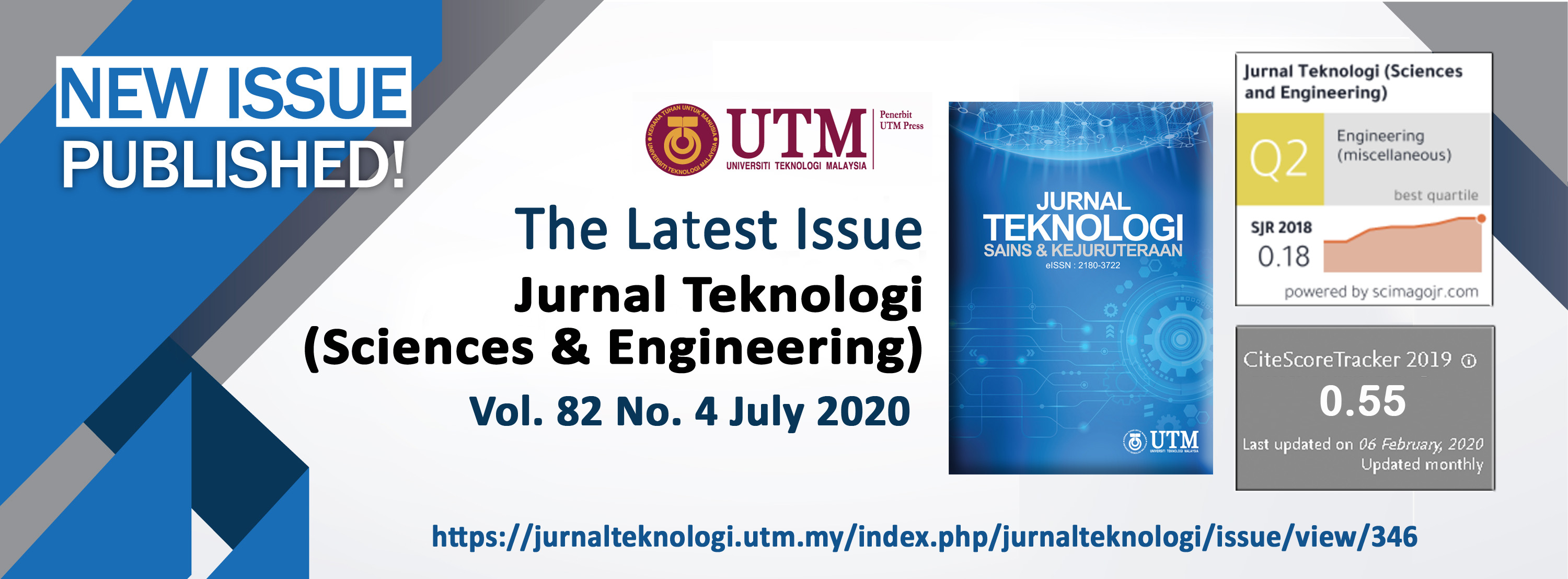DISCRIMINATION OF EXTRACTED ANIMAL FATS USING LASER-INDUCED BREAKDOWN SPECTROSCOPY ASSISTED WITH PRINCIPAL COMPONENT ANALYSIS
DOI:
https://doi.org/10.11113/jt.v82.14121Keywords:
LIBS, PCA, animal fats, plasma, liquid ablationAbstract
This study focuses on the discrimination of extracted animal fats in liquid form using laser induced breakdown spectroscopy (LIBS) technique assisted with principal component analysis (PCA). The interaction of laser and liquid sample produces liquid splashing due to strong shock wave effect and subsequently generates lower intensity of LIBS signals. LIBS difficulties in liquid are resolved using paper substrate to enhance LIBS emission intensity. Laser pulse from Q-switched Nd:YAG laser with energy of 220 mJ and frequency of 1 Hz was used to ablate extracted animal fats. The obtained LIBS spectra of extracted animal fats were further evaluated using PCA. LIBS spectra are compressed and visualised as data points in the score plot of PCA. PCA results demonstrated that data points from different extracted animal fats were clustered separately in the score plot with variance greater than 90%. The findings show LIBS system assisted with PCA was capable to differentiate various extracted animal fats.
References
Smith, S. B., & Smith, D. R. 2015. Fats: Production and Uses of Animal Fats. In Caballero, B., Finglas, P. M., & Toldrá, F. (Ed.). Encyclopedia of Food and Health. Oxford, UK: Elsevier Ltd. 604-608.
DOI: https://doi.org/10.1016/B978-0-12-384947-2.00273-7.
Syahariza, Z. A., Che Man, Y. B., Selamat J., and Bakar, J. 2005. Detection of Lard Adulteration in Cake Formulation by Fourier Transform Infrared (FTIR) Spectroscopy. Food Chemistry. 92: 365-371.
DOI: https://doi.org/10.1016/j.foodchem.2004.10.039.
Oroian F. C., and Petrescu-Mag, I.V. 2017. Old and New Perspectives of Using Pork Fat, Porcine Research. 7(1): 10-16.
Che Man, Y. B., Marina, A. M., Rohman, A., Al-Kahtani, H. A., and Norazura, O. 2014. A Fourier Transform Infrared Spectroscopy Method for Analysis of Palm Oil Adulterated with Lard in Pre-fried French Fries. International Journal of Food Properties. 17: 354-362.
DOI: https://doi.org/10.1080/10942912.2011.631254.
Kwon, D. Y., and Tamang, J. P. 2015. Religious Ethnic Foods. Journal of Ethnic Foods. 2: 45-46.
DOI: https://doi.org/10.1016/j.jef.2015.05.001.
Lingzhi, X., Fei, G., Zengling, Y., Lujia, H., and Xian, L. 2016. Discriminant Analysis of Terrestrial Animal Fat and Oil Adulteration in Fish Oil by Infrared Spectroscopy. International Journal of Agricultural and Biological Engineering. 9(13): 179-185.
Lee, J., Park, J., Mun, H., Shim, W., Lim, S., and Kim, M. 2018. Quantitative Analysis of Lard in Animal Fat Mixture Using Visible Raman Spectroscopy. Food Chemistry. 254: 109-114.
DOI: https://doi.org/10.1016/j.foodchem.2018.01.185.
Nizar, N. N. A., Marikkar, J. M. N., and Hashim, D. M. 2013. Differentiation of Lard, Chicken Fat, Beef Fat and Mutton Fat by GCMS and EA-IRMS Techniques. Journal of Oleo Science. 62(7): 459-464.
DOI: https://doi.org/10.5650/jos.62.459.
Bilge, G., Velioglu, H. M., Sezer, B., Eseller, K. E., and Boyaci, I. H. 2016. Identification of Meat Species by Using Laser-Induced Breakdown Spectroscopy. Meat Science. 119: 118-122.
DOI: https://doi.org/10.1016/j.meatsci.2016.04.035.
Mehari, F., Rohde, M., Kanawade, R., Knipfer, C., Adler, W., Stelzle, F. and Schmidt, M. 2016. Investigation of the Differentiation of Ex Vivo Nerve and Fat Tissues Using Laser-induced Breakdown Spectroscopy (LIBS): Prospects for Tissue-specific Laser Surgery. Journal of Biophotonics. 9(10): 1021-1032.
DOI: https://doi.org/10.1002/jbio.201500256.
Kanawade, R., Mehari, F. Knipfer, C., Rohde, M., Tangermann-Gerk, K., Schmidt, M., and Stelzle, F. 2013. Pilot Study of Laser Induced Breakdown Spectroscopy for Tissue Differentiation by Monitoring the Plume Created during Laser Surgery – An Approach on A Feedback Laser Control Mechanism. Spectrochimica Acta Part B. 87: 175-181.
DOI: https://doi.org/10.1016/j.sab.2013.05.012.
Wan, X., and Wang, P. 2015. Analysis of Heavy Metals in Organisms Based on an Optimized Quantitative LIBS. Optik. 126: 1930-1934.
DOI: https://doi.org/10.1016/j.ijleo.2015.05.039.
Yueh, F., Zheng, H., Singh, J. P. and Burgess, S. 2009. Preliminary Evaluation of Laser-Induced Breakdown Spectroscopy for Tissue Classification. Spectrochimica Acta Part B 64: 1059-1067.
DOI: https://doi.org/10.1016/j.sab.2009.07.025.
Harun, H. A., and Zainal, R. 2018. Laser-induced Breakdown Spectroscopy Measurement for Liquids: Experimental Configurations and Sample Preparations. Journal of Nonlinear Optical Physics & Materials. 27(2): 1850023.
DOI: https://doi.org/10.1142/S0218863518500236.
Al-Adel, F. F., Dastageer, M. A., Gasmi, K., and Gondal, M. A. 2013. Optimization of a Laser Induced Breakdown Spectroscopy Method for the Analysis of Liquid Samples. Journal of Applied Spectroscopy. 80(5): 767-770.
DOI: https://doi.org/10.1007/s10812-013-9839-8.
Bellof, G., Most, E., and Pallauf, J. 2006. Concentration of Ca, P, Mg, Na and K in Muscle, Fat and Bone Tissue of Lambs of the Breed German Merino Landsheep in the Course of the Growing Period. Journal of Animal Physiology and Animal Nutrition. 90: 385-393.
DOI: https://doi.org/10.1111/j.1439-0396.2006.00610.x.
Yu, K., Zhao, Y., Liu, F., and He, Y. 2016. Laser-Induced Breakdown Spectroscopy Coupled With Multivariate Chemometrics for Variety Discrimination of Soil. Scientific Reports. 6: 27574.
DOI: https://doi.org/10.1038/srep27574.
Porizka, P., Klus, J., Kepes, E., Prochazka, D., Hahn, D. W., and Kaiser, J. 2018. On the Utilization of Principal Component Analysis in Laser-Induced Breakdown Spectroscopy Data Analysis, A Review. Spectrochimica Acta Part B. 148: 65-82.
DOI: https://doi.org/10.1016/j.sab.2018.05.030.
Hanasil, N. S., Raja Ibrahim, R. K., Duralim, M., Sapingi, H. H. J., & Mahdi, M. A. 2020. EXPRESS: Signal Enhancement Evaluation of Laser Induced Breakdown Spectroscopy of Extracted Animal Fats Using a Principal Component Analysis Approach. Applied Spectroscopy.
Downloads
Published
Issue
Section
License
Copyright of articles that appear in Jurnal Teknologi belongs exclusively to Penerbit Universiti Teknologi Malaysia (Penerbit UTM Press). This copyright covers the rights to reproduce the article, including reprints, electronic reproductions, or any other reproductions of similar nature.
















